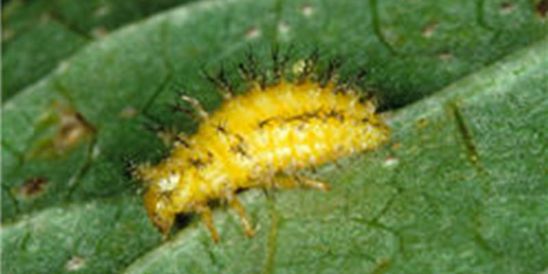Symptoms
Symptoms of the Mexican Bean Beetle
- Soybean plants can be severely defoliated by both adult and larvae, though the larvae usually are more damaging.
- Larvae strip away the top layer of leaf tissue between the veins, giving the leaves a skeletonized appearance. Adults consume all leaf tissue between major veins, producing a distinctive lacy appearance to the foliage.
Pest ID

Adult Mexican Bean Beetle.
- Adult Mexican bean beetles are oval, approximately 1/4 inch long and are yellow/orange in color. They have 16 small black spots on wing covers.
- Larvae are bright yellow with numerous black-tipped "spines" that look like burned pine trees. Pupae are also bright yellow and have only remnants of larval spines. Eggs are yellow and oval-shaped.

Mexican Bean Beetle larvae.
Life Cycle
Life Cycle of the Mexican Bean Beetle
- Adults overwinter in crop debris, woodlots or in stubble and can usually be found within 1/4 mile of the host plants.
- The overwintered adult can be found on soybean seedlings early in the season. 2 overlapping generations develop throughout the Midwest each year.
Management
- In soybeans, treatment may be warranted when defoliation reaches 30% before bloom and 7 or more adults and larvae can be found in 1 foot of beans in a row.
- For blooming or postbloom beans, treatment may be warranted when defoliation reaches 20% and 5 or more adults and larvae are present in 1 foot of beans per row.
- Consider the growth stage of the insect, cost of treatment, market price of the crop, growth stage of the crop and percentage of defoliation when making control decisions.
Photos courtesy of Marlin E. Rice.